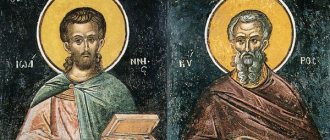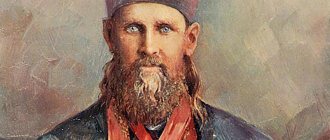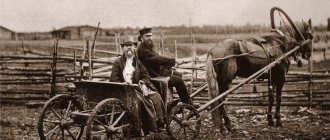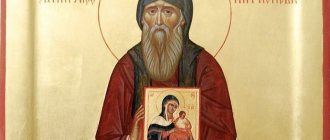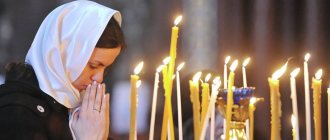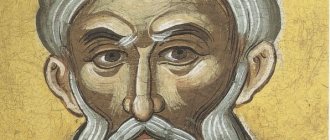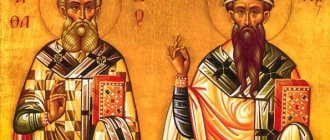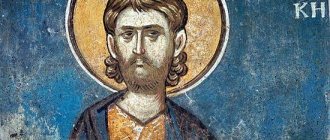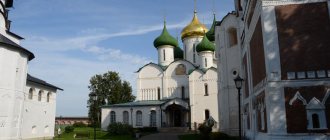| Ap. Luke the Evangelist. Icon, 1350-1360, Deesis tier of the iconostasis of the Athos Vatopedi Monastery. From the site ruicon.ru |
Luke
(+ c.), apostle from 70, evangelist, companion of the holy Apostle Paul, hieromartyr, physician, first icon painter Memory April 22, June 20 - for the transfer of relics (Greek [1]), October 18, in the Council of the Seventy Apostles, Achaian saints (Greek [2]) and Boeotian saints (Greek [2])
A native of Antioch in Syria [3]. He came from an enlightened Greek environment and was a Roman citizen. He became a doctor. Was not married [4].
Having heard about Christ, he arrived in Palestine and there he ardently accepted the saving teaching from the Lord Himself. Among the 70 disciples, he was sent by the Lord to preach the first sermon about the Kingdom of Heaven during the Savior’s life on earth (Luke 10:1-3). After the Resurrection, the Lord Jesus Christ appeared to him and Cleopas, who were going to Emmaus.
He took part in the second missionary journey of the Apostle Paul, and since then they have been inseparable. Saint Luke was present at the conversion of Lydia and her household, and he himself lived in her house. About him, together with the Apostle Paul, Timothy and Silas, a woman possessed by a prophetic spirit shouted: “These men are the servants of the Most High God, who proclaim to us the way of salvation” (Acts 16:17). He and Timothy were not taken into custody along with the Apostle Paul and Silas, probably because they did not look like Jews. When the apostle Paul left Philippi, Luke stayed behind to continue preaching the gospel—he was still there when Paul visited Philippi again.
When Saint Paul left Greece and went to Asia Minor, Luke accompanied him to Troas. Became an eyewitness to the attack on the Apostle Paul in Jerusalem on the steps of the Antonian Fortress and often visited him during his two-year stay in Caesarea. Then, together with Aristarchus, he accompanied Paul on his way to Rome, and with him survived the most dangerous sea voyage from Crete to the island of Melitus during a multi-day storm. He was next to Paul during the two years that he lived in custody in Rome. Probably at this time, in the years, under the leadership of the Apostle Paul, he wrote the Gospel and the book of the Acts of the Holy Apostles [5]. Saint Paul mentions him by name in his letters to the Colossians (Col. 4:14) and Philemon (Phil. 1:24), as well as in the second letter to Timothy, from which it is clear that when all his co-workers left Paul, the Apostle Luke continued to share with with him all the difficulties of the evangelistic feat (2 Tim. 4:10). Saint Luke was also present at the martyrdom of the Apostle Paul.
After the martyrdom of the chief apostles, he left Rome and preached through Achaia, Libya, Egypt and Thebaid [6].
He ended his earthly journey as a martyr in the city of Thebes, Greece. There is a legend that Saint Luke was crucified on an olive tree. At the same time, Julius Africanus does not talk about martyrdom, but only indicates that Saint Luke died at the age of seventy-four, “filled with the Holy Spirit” [7].
Tradition credits him with painting the first icons of the Mother of God. “May the grace of Him who was born of Me and My mercy be with these icons,” said the Most Pure Virgin, seeing the icons. Of the famous miraculous icons of the Most Holy Theotokos, Tradition attributes more than seventy icons to the authorship of the Apostle Luke. He also painted icons of the holy chief apostles Peter and Paul.
| St. Evangelist Luke. Russian icon |
Life of a Saint
The birthplace of the Evangelist Luke is Syrian Antioch. Coming from enlightened Greek society, he belonged to the respected profession of medicine. He was the ship's doctor and also versed in law. The short biography does not provide detailed information about the origin of the future apostle, the author of the Gospel.
When Christian teaching came to his region, Luke listened to the good news. Presumably, he had already converted to Judaism by that time. His extensive knowledge of the laws of Moses and the customs of the Jewish faith is revealed in his writings.
Meeting with the Savior
The Greek physician went to Palestine, found Jesus and joined His disciples. The Savior sent seventy apostles and Luke among them to preach about the Kingdom of Heaven. And after the Resurrection, Christ appeared to the future evangelist and his comrade-in-arms Cleopas as they walked to the city of Emmaus.
Brothers in faith walked and talked about the execution of the Teacher in Jerusalem. They did not hope for the quick establishment of the Kingdom of Christ on earth. A stranger approached them and asked why the travelers were sad. And then he explained that the suffering of the Son of God for the salvation of the human race was predicted by the Old Testament prophets.
The three of them walked the rest of the day. In the evening, the apostles invited the stranger to a meal. When they broke bread together, the preachers recognized the risen Teacher in the stranger. The apostle returned the right hand of John the Baptist to his homeland.
After the Ascension of the Lord, Luke went home to Antioch. On the way, he stopped in Sebastia and wanted to pick up the relics of John the Baptist kept there. Due to the protest of local Christians, he only managed to receive the right hand that blessed Christ. In Antioch the relic was received with joy. The Greek doctor made the next journey together with the Apostle Paul.
Luke and Paul
The future evangelist accompanied one of the first disciples of Christ during a missionary journey and did not leave him during the persecution against Christians, like other associates. His medical knowledge came in handy along the way - Luke treated Paul. They preached in Greece and Macedonian Philippi.
The faithful disciple and physician accompanied Paul during his arrest in Caesarea, crossing by sea and two-year imprisonment in Rome. In the Eternal City, Luke compiled the Gospel under the direction of Paul. When the prisoner was released, they visited several previously founded churches and returned to Rome.
By that time, Emperor Nero, who persecuted Christians, had taken the throne. Paul supported the believers with sermons, and he was arrested again.
In a letter to his disciple Timothy, he wrote that everyone abandoned him except Luke. The evangelist did not leave the teacher until his death.
Missionary and demise
After the execution of Paul, Luke independently preached in Achaia, Libya, Egypt and Thebaid. He traveled to Gaul and Africa. He collected alms for Christians in Palestine and devoted several years to spreading Christianity in Macedonia.
The Apostle built Christian communities, preached and healed with the power of faith, blessed deacons and elevated them to bishops. In Greek Thebes, at the age of 84, he was overtaken by the death of a martyr - the apostle was crucified on an olive tree.
Luke was buried in Thebes. In the 4th century, the miraculous relics of the apostle were transferred to Constantinople. People were especially often healed from eye diseases. The remains were placed in the temple next to the relics of the apostles Andrew and Timothy. A terminally ill eunuch helped carry the shrine containing Luke’s relics. After walking a few steps, he was healed.
The relics were transported to Constantinople by the Egyptian military leader and later martyr Artemius of Antioch, on the initiative of Emperor Constantius. During the capture of the Byzantine capital by the Turks, the Venetians allied with Constantinople took the remains to Italy.
Apostle and Evangelist Luke
Saint Luke the Evangelist was born in the Syrian city of Antioch. His parents did not belong to the Jewish tribe: this is evidenced in part by the very name Luke, abbreviated from the Latin word “Lucan” [1], and especially by one place from the letter of the Apostle Paul to the Colossians, where Saint Paul clearly separates Luke from “ those who have been circumcised.” “, i.e., the Jews (Col. 4:10-15).
In his writings, however, Luke reveals a thorough acquaintance with the law of Moses and Jewish customs; Therefore, one can think that Luke, even before his conversion to Christ, had already accepted the Jewish faith [2]. In addition, in his homeland, famous for the flourishing state of the sciences and arts, Luke enriched his mind with various scientific information.
From the letter of the Apostle Paul to the Colossians we see that Luke studied the art of medicine [3]; Tradition confirms to us that he was also a painter. There is also no doubt that he received a generally good education, because the Greek language of his writings is much purer and more correct than the language of other New Testament writers.
When the rumor about the miracles and teachings of the Lord Jesus Christ spread from Galilee throughout Syria and all surrounding places, then Luke arrived from Antioch to Galilee, where the Lord Jesus Christ began to sow the seeds of His saving teaching (Matt. 4: 24-26. Luke. 4:37). These seeds found good soil in Luke’s heart and bore a hundredfold fruit here. Soon Saint Luke was honored to be accepted into the ranks of the 70 apostles of Christ and, having received parting instructions from the Lord and the power to perform miracles, he began to walk “before the face” of the Lord Jesus Christ, preaching about the coming of the Kingdom of God and preparing the way for Christ the Savior [4].
In the last days of the Savior’s earthly life, when with the defeat of the Shepherd the sheep of His flock were scattered, Saint Luke was in Jerusalem, lamenting and crying for his Lord, who suffered freely. Probably, during His crucifixion, among others who knew Jesus, Luke stood “ afar off ” and looked with sorrow at the Crucified One (Luke 23:49). But soon his sorrow turned into joy, for the Risen Lord, on the very day of His resurrection, consoled Luke, worthy of him with His appearance and conversation, which Luke himself reports with particular detail and vividness in his Gospel [5].
Grieving over the death of his Teacher and perplexed about His resurrection, which the myrrh-bearing women told him about, Luke walked with another disciple of the Lord, Cleopas, from Jerusalem to Emmaus [6], and on the way to this village was honored to become a companion of the One who is “ the way, the truth and the life " [7]. The two disciples were walking and talking with each other when Jesus Himself approached them and walked with them. The Lord appeared to them, according to the Evangelist Mark, “ in a different form ” (Mark 16:12), and not in the form in which they knew Him before. In addition, according to a special dispensation of God, “ their eyes were held back ” (Luke 24:16), so that they could not recognize the Lord who had appeared. They thought that one of the pilgrims who went to Jerusalem for Easter was coming with them.
- What are you talking about among yourself as you walk, and why are you sad? - the Lord asked them.
To this Cleopas said:
“Are you really one of those who came to Jerusalem and don’t know about what happened in it these days?”
- About what? – Jesus asked again.
“What happened to Jesus of Nazareth,” they answered, “who was a prophet, mighty in deed and word before God and all the people; how the chief priests and our rulers delivered Him up to be condemned to death, and crucified Him. But we hoped,” the disciples continued their speech, “that He was the One who should deliver Israel; but with all that, it is now the third day since this happened. But some of our women also amazed us: they were early at the tomb and did not find His body, and when they came, they said that they had also seen the appearance of Angels, who said that He was alive. And some of our men went to the tomb and found it just as the women had said, but they did not see Him. Then the Lord said to them:
- Oh, foolish ones and slow of heart to believe everything that the prophets foretold! Is this not how Christ had to suffer and enter into His glory?
And beginning with Moses, Christ the Lord of all the prophets explained to them what was said about Him in all Scripture.
Thus talking with the Lord, the disciples quietly approached Emmaus, and since they enjoyed the conversation, and their Companion apparently intended to go further, they began to ask Him to stay with them.
“Stay with us, because the day has already turned to evening,” they told Him.
And He entered the village and stayed with them in the same house. When He lay [8] down with them at supper, He took bread from the table, blessed it, broke it, and gave it to them. As soon as the Lord did this, the disciples immediately recognized Him. In all likelihood, the Lord performed this action before the disciples, and besides, they could recognize Him by those ulcers from the nails that they noticed on His hands. But at that time the Lord became invisible to them, and they said to each other:
– Didn’t our heart burn within us when He spoke to us on the road, and when He explained the Scripture to us? (Luke 24:17-32)
Wanting to share their joy with other disciples of the Lord, Luke and Cleopas immediately got up from the supper and went to Jerusalem. There they found the apostles and other disciples gathered in one house and, of course, immediately announced to them that Christ had risen, and that they had seen Him and talked with Him. The apostles, for their part, consoled them, saying that the Lord had truly risen and appeared to Simon. Then Luke and Cleopas told the Apostles in detail about everything that happened to them on the way and how they recognized Christ the Lord in the breaking of bread.
During this conversation, suddenly the Risen Lord Himself appeared among the Apostles, gave them peace and calmed their troubled hearts. To reassure those who thought that they saw before them only the ghost of their dead Teacher, the Lord showed the wounds from the nails on His hands and feet and tasted the food. The Evangelist Luke here again was honored to hear from the Lord an explanation of everything that was said about Him in the Holy Scriptures of the Old Testament, and received the gift of understanding of the Scriptures (Luke 24:18-49).
After the Ascension of the Lord, Saint Luke stayed for some time, together with the other Apostles, in Jerusalem, but then, according to tradition, he went to his homeland, Antioch, where there were already many Christians. On the way there, he preached through the city of Sebastia [9], where the incorrupt relics of St. John the Baptist were located. Leaving Sebastia, Saint Luke wanted to take them with him to his homeland, but the Christians there, diligently honoring the Baptist of the Lord, did not allow Luke to take his holy relics. Then Saint Luke took from them the right hand, under which Christ once bowed His head, receiving baptism from John.
With this priceless treasure, Saint Luke arrived in his homeland, to the great joy of the Antiochian Christians. He left from here only when he became a companion and collaborator of the holy Apostle Paul, who, according to some ancient writers, was even a relative of him. This happened, however, already during the second apostolic journey of St. Paul [10]. At this time, Saint Luke, together with the Apostle Paul, went to preach in Greece and was left by him to establish and establish the Church in the Macedonian city of Philippi; Saint Luke from that time, for several years, worked to spread Christianity in Macedonia [11].
When the Apostle Paul, at the end of his third apostolic journey, again visited Philippi, Luke, on his instructions and by the election of all believers, went to Corinth to collect alms in favor of the poor Christians of Palestine [12]. Having collected alms, Saint Luke and the Apostle Paul set off for Palestine, visiting churches along the way that were located on the islands of the Archipelago, along the shores of Asia Minor, in Phenicia and Judea. When the Apostle Paul was taken into custody in the Palestinian city of Caesarea, Saint Luke remained with him. He did not abandon the Apostle Paul even when he was sent to Rome to be judged by Caesar. He, together with the Apostle Paul, endured all the difficulties of traveling by sea, and was in danger of even losing his life [13].
Arriving in Rome, Saint Luke also stayed with the Apostle Paul and, together with Mark, Aristarchus and some other companions of the apostle, preached Christ in this capital of the ancient world [14]. In Rome, Saint Luke wrote his Gospel and the book of the Acts of the Holy Apostles [15]. In the Gospel, he depicted the earthly life of our Lord Jesus Christ not only on the basis of what he himself saw and heard, but also taking into account everything that was betrayed by “who were from the very beginning eyewitnesses and ministers of the Word ” [16]. The Holy Apostle Paul guided him in this matter and then approved the Gospel written by St. Luke. In the same way, the book of the Acts of the Apostles was written, as church tradition says, at the command of the Apostle Paul [17].
After two years of imprisonment in Roman bonds, the Apostle Paul received freedom and, leaving Rome, visited some of the churches he had previously founded. Saint Luke also accompanied him at this time. In a short time, Emperor Nero launched a fierce persecution against Christians in Rome. At this time, the Apostle Paul arrived in Rome another time in order to encourage and support the persecuted Church with his word and example and, if God willed, to share the crown of martyrdom with the believers. He was taken by the pagans and imprisoned. Saint Luke, even now, did not betray his teacher, and only one of all the apostle’s colleagues was with him at this time, so difficult that the apostle compared himself to a victim doomed to slaughter.
“I am already becoming a victim,” wrote the Apostle Paul to his disciple Timothy, “and the time of my departure has come: try to come to me as soon as possible.” For Demas left me, having loved the present age, and went to Thessalonica, Crescent to Galatia, Titus to Dalmatia. Only Luke is with me [18].
It is very likely that Luke witnessed the martyrdom of the Apostle Paul in Rome. After the death of the Apostle Paul, Saint Luke, as church tradition says, preached Christ in Italy, Dalmatia, Gaul, and especially in Macedonia, in which he had previously worked for several years, as well as in Achaia, neighboring Macedonia [19].
Already in old age, the Apostle Luke undertook a journey to distant Egypt and endured many labors and sorrows here for the sake of the glory of the holy name of Jesus. He came to Egypt, having first passed through all of Libya [20], and in Egypt - in Thebaid - he converted many to Christ. In the city of Alexandria, he ordained a certain Avilius as bishop, in place of Annianus, who was ordained by the Evangelist Mark and served for 22 years. Returning to Greece, he again established churches here, mainly in the region of Boeotia [21], ordained priests and deacons, and healed the sick physically and mentally. Like his friend and leader, the Apostle Paul, Saint Luke “ fought the good fight, completed his course and kept the faith .” He died at the age of 84, in Achaia, as a martyr, namely, being hanged, for lack of a cross, on an olive tree [22]. His honest body was buried in Thebes, the main city of Boeotia, where his holy relics, which provided many healings, were kept until the second half of the fourth century, and then were transferred to the capital of the Eastern Empire - Constantinople.
The location of the relics of the Holy Apostle Luke became known in the fourth century due to the healings that were performed here. Especially many healings were performed here on those suffering from eye disease [23]. The son of Equal-to-the-Apostles Constantine the Great, Emperor Constantius, having learned from one Achaian bishop that the body of St. Luke rested in Thebes, sent the ruler of Egypt Artemius [24] to transfer the relics of St. Luke to the capital, and he performed this transfer with great triumph [25].
During the transfer of the holy relics of Luke from the seashore to the temple, such a miracle took place. A certain Anatoly, a eunuch (one of the royal bed servants), was sick with an incurable disease. He spent a lot of money on doctors, but could not receive healing, and now, with faith in the miraculous power of the holy relics of the Apostle Luke, he began to pray to the saint for healing. At the same time, he approached the holy shrine of the saint and, as much as he had the strength, helped to carry it. And what? The illness left him as soon as he walked a few steps. After this, he joyfully carried the honorable shrine to the Church of the Holy Apostles, where the relics of St. Luke were placed under the altar, along with the relics of the holy apostles Andrew and Timothy [26]. Here the holy relics were a source of miracles and were honored with special love by Orthodox Christians.
Ancient church writers report that Saint Luke, satisfying the pious desire of the leading Christians, was the first to paint the image of the Most Holy Theotokos holding in her arms the Eternal Child, our Lord Jesus Christ, and then he painted the other two icons of the Most Holy Theotokos and brought them for the consideration of the Mother of God. She, having examined these icons, said:
– May the grace of the One born of Me and My mercy be with these icons [27].
Saint Luke also wrote on the boards images of the holy chief apostles Peter and Paul, and with this laid the foundation for a good and honorable work - the writing of holy icons for the glory of God, the Mother of God and all the Saints, for the decoration of holy churches and for the salvation of believers who piously venerate these holy icons. Amen.
Troparion, tone 5:
We praise the apostolic acts of the narrator and the Gospel of Christ as a luminous writer, Luke, the glorious being of the Church of Christ, with the sacred hymns of the holy apostle we praise, as a physician, human infirmities, natural illnesses and illnesses of souls, healing and praying unceasingly for our souls.
Kontakion, voice 2:
Let us praise the true piety of the preacher, and the unspeakable mysteries of the rhetorician, the ecclesiastical star, the divine Luke: for his word was chosen, with Paul the wise teacher of tongues, the only one who knows the heart.
Notes:
[1] This name - "Lucan" - is found in some ancient manuscripts of the Latin translation of the Gospel of Luke. An example of such a shortening of a name can be seen in the name Sila, which is shortened from Silouan. (Acts 15:22; 2 Cor. 1:19, etc.).
[2] The pagans who accepted the Jewish faith were called sojourners of the gates, and whoever among them, along with the Jewish faith, accepted circumcision, was called a sojourner of righteousness. These were the leading church: a nobleman of the Ethiopian queen Candace, baptized by the Apostle Philip (Acts 8:27-40); such was the Roman centurion Cornelius (Acts 10:1-3); such was one of the seven deacons - Nicholas, born, like Luke, an Antiochian (Acts 6:6) and many others (Matthew 23:15; Acts 2:10).
[3] Ap. Paul directly calls Luke the beloved physician: “Luke, the beloved physician, kisses you,” he says (Col. 4:14).
[4] Luke 10:1-24. – This tradition is not contradicted by the words of Luke himself, in which he seems to exclude himself from the number of the Apostles - the self-viders of the Word (Luke 1:2). With these words St. Luke only wants to say that he did not belong to the ranks of the 12 apostles, who, of course, saw much more gospel events than the 70 disciples of the Lord who walked ahead of Him during the preaching of Christ.
[5] Luke 24:13-32. Although Luke himself in his Gospel does not call himself by name, the very detail of his narrative shows that he himself was that other disciple, whose name he did not mention. Church tradition also speaks about this. And in the church prayer for those preparing to set off on the journey, we read: “The Savior, who traveled to Emmaus to Luca and Cleopas, descended and now to your servants who want to travel.”
[6] Emmaus is a village located 60 stadia (about 12 versts) west of Jerusalem.
[7] Words of Christ the Savior Himself, John 14:6
[8] The ancient Jews did not sit. and reclined at mealtime
[9] Sebastia is the main city of Samaria.
[10] This apostolic journey lasted from 52 to 55 AD.
[11] Acts. 20:6. – Macedonia was located north of Greece, between Illyria, Thrace, the Aegean Sea and Geta or the Balkans. For some time it constituted an independent state, which especially rose and became famous under Tsar Alexander the Great; however, it fell just as quickly as it rose quickly. At the time of the apostles, Macedonia was part of the Roman Empire. Now it is in the power of the Turks. – Philippi is a Macedonian border city, named after the Macedonian king Philip, who restored and strengthened it.
[12] “We also sent with him a brother (the Apostle Titus), praised in all the churches for his gospel, and moreover chosen from the churches to accompany us for this good work, which we serve for the glory of the Lord Himself and in accordance with your zeal” (2 Cor. 8). :18-19). Ancient interpreters understand “brother” as the Apostle Luke. Saint John Chrysostom sees here an indication of the consecration of Saint Luke as a bishop (in the word consecrated) in Greek - “khirotonifis”.
[13] The disasters of this long journey were described by the holy Apostle Luke in the 27th and 28th chapters of the book of Acts.
[14] This is clear from the letters of the Apostle Paul to the Colossians and Philemon written at that time.
[15] Judging by the close connection between this Gospel and the book of the Acts of the Apostles (Luke 1:1-4; Acts 1:1), written after the Gospel and appearing in Rome around the year 63, it must be admitted that between the writing of both books very little time passed, and that the Gospel also appeared in Rome around the year 61 or 62. This is also confirmed by the signatures found on some manuscripts. – Both his Gospel and the book of the Acts of the Apostles, St. Luke wrote for a certain “sovereign” Theophilus (Luke 1:3; Acts 1:1). An ancient legend speaks of a certain noble Christian - Theophilus of Antioch, by whom they mean the one for whom the St. Luke's Gospel and Acts of the Apostles.
[16] Luke 1:2. – “Compared to other writers of the Gospel, Saint Luke is different,” as St. John Chrysostom, - with the greater completeness with which he embraces the New Testament events, starting from the birth of St. John the Baptist, of whom he alone speaks. In the same way, the last gospel event - the ascension of Jesus Christ into heaven - is not mentioned at all in Matthew and John, and mentioned in little detail in Mark - Saint Luke alone told in detail. – The Holy Gospel of Luke, according to the charter of the Orthodox Church, except for special cases, is read at the liturgy on all days from the 17th to the 29th week after Pentecost; from the 29th week until the Meat Week - only on Saturdays and Sundays, and on Monday, Tuesday and Thursdays of the Meat Week.
[17] In the book of Acts of St. of the apostles, Luke described in detail the descent of the Holy Spirit on the apostles and their exploits, performed by them after the Ascension of the Lord to spread and establish the Christian faith in Judea and other countries of the universe. “Mostly St. Luke, as St. says. John Chrysostom, described here the acts of St. Apostle Paul, whose beloved disciple and closest collaborator he was.”
[18] 2 Timothy 4:6,10. - Maybe St. Luke, both before and at this time, with his medical skill, alleviated the illnesses of the apostle - a prisoner who, as church tradition says, suffered from headaches and other bodily ailments, and for this he earned from the apostle the name “ beloved physician .”
[19] Dalmatia is the southern part of the Illyrian province, which bordered on the north with Pannonia, on the west with Italy and the Adriatic Sea. – Gaul included the lands lying between the ocean, the Pyrenees, the Mediterranean Sea, the Alps and the Rhine. Achaia is a region in southern Greece, occupying the northern part of the Morea peninsula.
[20] Libya is a province in northern Africa. There were many Greek colonies there (the Greeks, however, sometimes called all of Africa Libya).
[21] Boeotia is a region of central Greece.
[22] As St. Gregory the Theologian in his first word on Emperor Julian.
[23] As if to commemorate the medical skill of the Apostle Luke, the Lord rained down on the burial place of the holy Apostle the healing “kallurium”, i.e. medicinal lotion for eye disease.
[24] This Artemy died a martyr’s death under the Emperor Julian the Apostate; his memory is October 20th.
[25] Transfer of the relics of St. Luke The Church remembers April 22nd.
[26] Saint Andrew the First-Called, is an apostle of the 12. – Saint Timothy, an apostle of the 70, was a bishop in the city of Ephesus (in Asia Minor).
[27] The Orthodox Church, honoring the holy icons of the Mother of God, appeals to Her like this in her hymns: “First of all, to the icon that was written on yours, the Gospel mysteries as a harbinger, and to you; To the most beloved queen, may you accept Thee and do the utmost to save those who honor Thee, and may Thou rejoice, since You are merciful, the creator of our salvation.” (Stichera from the service to the Kazan Icon of the Mother of God, October 22). – In Moscow, in the Assumption Cathedral, the (Vladimir) icon of the Mother of God is kept, which, according to church tradition, was also painted by St. Luke.
Life as presented by St. Demetrius of Rostov
Where can you find relics
The remains of the Apostle Luke are located in the Venetian city of Padua, in the Catholic Basilica of Santa Giustina. The basilica stands in the central square of the city of Prato della Valle and belongs to the Benedictine abbey. The relics of the Apostle Matthew are also buried in the church.
The incorrupt body of the Evangelist Luke, excluding the head, is in the chapel under the icon of the Mother of God, painted by the apostle. The frescoes on the walls of the chapel depict episodes from the life of the Evangelist Luke.
In 1990, the particle was returned to Thebes. In the old temple, on the site of the apostle’s grave, a marble tomb remained. Its walls exude a substance that is healing for the eyes. In Latin it is called callurium, and in Greek it is called colidia.
The head of the Apostle Luke was kept in the Vatican in St. Peter's Basilica and on Mount Athos in the Iveron Monastery. Now the upper part of the skull is kept in Prague in the Cathedral of St. Vitus, and the lower part is kept in the Athonite Russian St. Panteleimon Monastery.
Miracles of icons
The Vladimir Icon of the Mother of God received its name from its location. This icon came to the territory of Rus' from Constantinople as a gift from the Byzantine emperor.
An interesting historical fact is associated with this icon: during the Tatar-Mongol invasion in 1395, the image was brought to Moscow, and Tamerlane’s army retreated for some unknown reason.
The Tikhvin icon was also brought to Rus' from Byzantium, but in an unusual way. This happened 70 years after the fall of Constantinople under pressure from the Ottoman Empire. The Face appeared in several places in the Novgorod lands, after which it “settled” on the banks of the Tikhvinka River. The image has become revered throughout Russia, and in our time is located in the monastery of the same name at the place where it was found.
The Iveron Icon of the Mother of God was painted by the apostle himself and was transported by sea to the shores of Athos, where it found a permanent refuge. The face is considered to be the protector of the Iveron Monastery; an interesting fact is known: the place of stay in the monastery - in the gate church - was chosen by the Mother of God herself, every night miraculously transferring the image through the air from the cathedral church to the entrance gate of the monastery.
Memorial Days
In the Orthodox Church, the evangelist is venerated 4 times a year:
- January 17 (January 4) - Council of the 70 Apostles;
- May 5 (April 22) - 4th week of Easter, not a fast day;
- July 3 (June 20) - 6th week after Pentecost, Peter's Fast;
- October 31 (October 18) is the day of remembrance of the Evangelist Luke.
Every October in Thebes, a divine service and religious procession are held at the tomb of the saint.
Prayer to Luke for healing
O all-blessed confessor, holy saint, our Father Luke, great servant of Christ. With tenderness we bow the knee of our hearts, and falling before the race of your honest and multi-healing relics, like the children of our father, we pray to you with all zeal: hear us, sinners, and bring our prayer to the merciful and humane God, to whom you are now in the joy of the saints and from the faces of an angel coming. We believe that you love us with the same love that you loved all your neighbors while you were on earth. Ask Christ our God to confirm His children in the spirit of right faith and piety: to the shepherds to give holy zeal and care for the salvation of the people entrusted to them: to observe the right of believers, to strengthen the weak and infirm in the faith, to instruct the ignorant, to reprove the contrary. Give us all a gift that is useful to everyone, and everything that is useful for temporary life and eternal salvation: the establishment of our cities, the fruitfulness of the land, deliverance from famine and destruction, consolation for the afflicted, healing for the sick, return to the path of truth for those who have gone astray, blessing for the parent, blessing for the child in distress. The Lord's upbringing and teaching, help and intercession for the orphaned and needy. Grant us all your Archpastoral blessing, so that if we have such prayerful intercession, we will get rid of the wiles of the evil one and avoid all enmity and disorder, heresies and schisms. Guide us on the path leading to the villages of the righteous, and pray to the almighty God for us in eternal life
Let us be worthy with you to continually glorify the Consubstantial and Indivisible Trinity, the Father and the Son and the Holy Spirit. Amen.
In front of the icon of St. Luke, a prayer is also read for well-being in the house, thanks to which peace and order reign in the family. For men who love to go fishing and are waiting for a successful catch, you need to read a prayer to the Apostle Luke about fishing, after which they will definitely have a big catch.
The best article for you, go to: Icon of Zosima and Savvaty of Solovetsky
The icon of the Apostle and Evangelist Luke is of great importance for all Christian believers, since the preacher was a great man, thanks to the saint, people learned about the life of Christ, his deeds and the feat that he did in the name of all mankind.
Creative heritage
Luke is known as the first icon painter. He painted a portrait of the Most Pure Virgin with the Eternal Child on a board from the dining table at which Mary, Jesus and Joseph ate. The Mother of God blessed this and subsequent images. The apostle is also the author of the icons of the apostles Peter and Paul.
Icons
According to the Russian Orthodox Church, he painted 10 images of the Virgin Mary. On Mount Athos there are 21 of his icons, 8 of which are kept in Rome.
Famous images of the Mother of God, painted by the Apostle Luke:
- “Iverskaya” from the Iversky Monastery on Athos;
- “Eleusa” or “Vladimirskaya” from the Church of St. Nicholas at the Tretyakov Gallery;
- "Kykkos" from the Kykkos Monastery in Cyprus;
- “Sumelskaya” from a temple in the Greek village of Kastanya;
- "Tikhvinskaya" from the Russian Tikhvin Monastery.
Apostle Luke is the author of the “Hodegetria” icon, also known as the “Guide” or “Kazan”.
New Testament
The Gospel of Luke is valuable for its presentation of the universal significance of Christian preaching. The work tells of the universality of salvation brought by Christ. Compiling the third biography of Christ, the author studied the Gospels of Matthew and Mark.
Luke is called a historian of the times of Christ. His Gospel is based on facts, presented sequentially, in a historical genre. It is written in Greek and is revered as an example of ancient literature.
Elegant storytelling consists of prose and poetry. Only Luke's portion of the New Testament includes hymns, aphorisms, and teachings in the Old Testament style. It was Luke who wrote the famous parables about Lazarus and the rich man, the Good Samaritan, the Prodigal Son and other stories known even to people who have not read the Bible. The Greek physician's account differs in that he named the diseases that Christ healed.
The Apostle's Gospel is unique because it tells about the childhood of Jesus. Only Luke described the story of how little Jesus was returning from a holiday from Jerusalem and went into His Father’s House, into the temple. Mary searched for Him for a long time and found Him sitting in the circle of the high priests and preaching the wisdom of God. No one could tell the evangelist about this incident except the Most Pure Virgin. From her words, he described in detail the Annunciation, the meeting with Elizabeth and the birth of Christ.
Luke is the only New Testament author who is not of Jewish origin. He himself was not an eyewitness to the events in Jerusalem, unlike Mark and Matthew.
The apostle became a participant in the miracle only on the road to Emmaus. He told about his meeting with Christ at the end of the Gospel. He did not give his name, but told about his student Cleopas and the second nameless student. The incident is described in detail. It appears that the unnamed disciple was Luke himself.
Acts of the Apostles
While in Rome, Luke also wrote a book about the acts of the holy apostles. The essay describes the exploits of Christ's disciples after His Ascension. The first part talks about John and Peter, and the second talks about Paul, who first blasphemed Christians. Thanks to the power of Divine Love, Paul came to know true faith and became a disciple of Christ.
The book "Acts of the Apostles" continues the New Testament. The work is devoted to the theme of the Household of the Holy Spirit in the Church erected by the Savior, from His Ascension to the Second Coming. The Apostolic Council in the 51st year of Christ appears in the narrative as the line that divided Judaism and Christianity.
Icon of Luke of Crimea
This saint is revered as a miracle worker on a par with Nicholas the Pleasant and other saints especially valuable to Orthodox Christians. At first, he led the life of a simple educated person: in his youth he was engaged in painting, after which he received a medical education and served as a surgeon, including as a volunteer during the Russian-Japanese War.
Further, his story is connected with many years of surgical activity. At the same time, the doctor was highly religious and always had an icon in his operating room, which he touched before starting work.
After his wife died, Valentin Feliksovich (secular name) was ordained and began spiritual asceticism. As a result, he was first a priest in the temple, and then became a monk and became a bishop. At the same time, he conducted spiritual activities and sermons no less in the period from the 1920s, that is, precisely when churches were destroyed, and Christianity was not particularly popular, and other doctors were skeptical about Valentin’s activities.
However, now the icon of St. Luke Voino Yasenetsky (the saint’s surname) is in many homes, but they don’t even remember those doctors. What is surprising here is the continuous activity of the saint in the field of medicine; he continued to practice continuously and not only preached, but also wrote valuable medical books. They are still in demand.
Before World War II, he was persecuted and spent a lot of time in prison. At the end of the war, he managed to gain recognition and be amnestied.
After and until his death he was Bishop of Crimea and Simferopol, in this post he carried out active preaching activities and received the sick.
Iconography
Since the 2nd century, evangelists have been marked with symbols to fully reveal the personality of the Savior.
The symbol of the Apostle Luke is a winged calf holding the Gospel from the prophecy of Ezekiel. The sacrificial animal is depicted on the icons of the apostle and is associated with the death of Christ on the cross. The evangelist attached special significance to it and revealed in detail its saving significance for people in his writings.
Images of the evangelists have been placed on the Royal Doors of the iconostasis since about the 14th century. They are usually depicted working on the Holy Scriptures. But Luke is also depicted painting icons. There is a well-known Pskov icon from the 16th century, on which an easel stands in front of the apostle, with paint nearby. Luka holds a brush in his hand. He paints the image of the Mother of God.
Icons of St. Apostle Luke
The life of the Apostle Luke was captured by icon painters on holy images. On the icons the martyr is mainly depicted as a man of about forty. He is dressed in loose clothes, painted in blue and red shades. In his hands the man holds a book in which he describes the life of Jesus Christ. There is a halo above his head. Also on some icons the preacher is depicted with a staff in his hands - this is a biblical symbol that shows that its owner is blessed by God for pastoral service.
There is also an icon of the Holy Apostle Luke, on which the saint is depicted in a white cassock, with a panagia on his chest, sitting at a table during scientific work. Sometimes a set of medical instruments is depicted next to Luke - this indicates the man’s occupation, the fact that he was a doctor and not only saved people from illnesses, but also saved them from disabilities. The doctor saved many lives, because in those days many medical methods were inaccessible to ordinary people.
The symbol of the martyr, thanks to which his works are recognized, is the winged bull from the Bible. This symbol arose due to the fact that in his Gospel the saint pays a lot of attention to the crucifixion of Christ, and the bull is a symbol of sacrifice.
Notes[ | ]
- Holy Apostle and Evangelist Luke Archived copy of January 14, 2018 on the Wayback Machine // Eulogite! Guide to the holy places of Greece. Nun Nektaria (Mc Leese), trans. from English, Publishing house "Russian Pilgrim". M., 2007
- Bratkin D.
Was the Evangelist Luke a legal consultant to the Apostle Paul? // Pages: theology, culture, education. 13:1 (2008/2009). pp. 3-33. - Apostle of the 70 Luke the Evangelist
- A. P. Golubtsov “From readings on church archeology and liturgics.” St. Petersburg, 1917 p. 204
- Theodore Anagnost "Ecclesiastical History"
- Volkov D.V.
Alphabetical index of the names and locations of icons of the Mother of God, the origin of which is linked by tradition with the name of St. Evangelist Luke.
Blachernae icon
This image was half-length. His lists - and lists from lists - number in the tens and hundreds. In Byzantium, this is the Mother of God Perivelept of the 14th century, Psychosostria (Soul Savior) of 1312-1325. In later Greece - Our Lady of Sumel and Kykkos.
In Rus' - Our Lady of Smolensk, Tikhvin, Kazan. Georgian. Iverskaya. In Poland - Częstochowa.
There are lists in Italy too. The historical, “first” Blachernitissa has not reached us, but the obvious similarity of her successors gives a very clear idea of the type of belted Hodegetria. The oldest of them is Smolenskaya.
The appearance of Hodegetria
First of all: historically, the “icon of Luke” is considered to be the type of Our Lady Hodegetria - on it Christ blesses with his right hand, holds a scroll or book in his left, appearing as a shepherd and Savior; The Mother of God supports him with her left hand; she sits calmly and turns towards those ahead, representing the image of the Church.
The image painted by Luke was originally located in his hometown of Antioch, then was transferred to Jerusalem, and from there in 439, Empress Eudokia, wife of Theodosius II, brought it to Constantinople and gave it to her husband’s sister, Pulcheria. Then the first “split” of the legend arises: according to one version, Pulcheria presented the icon to the Blachernae church, which is why the image began to be called Blachernae; according to another, the icon was placed in the Odigon monastery.

